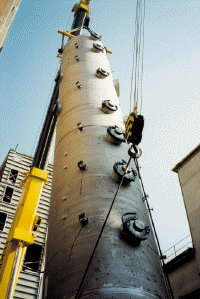
Deodoriser
Encyclopedia

Refining
Refining is the process of purification of a substance or a form. The term is usually used of a natural resource that is almost in a usable form, but which is more useful in its pure form. For instance, most types of natural petroleum will burn straight from the ground, but it will burn poorly...
. Deodorising removes odoriferous material, free fatty acids and other undesired minor components to produce a bland oil with a good shelf life.
State-of-the-art
Over the latest years, the aim of a state-of-the-art deodorising became:Maximise:
- odor, flavor removal
- free fatty acid removal
- color reduction (heat bleaching)
- peroxides destruction
Minimise:
- losses in essential fatty acids (EPAEicosapentaenoic acidEicosapentaenoic acid is an omega-3 fatty acid. In physiological literature, it is given the name 20:5. It also has the trivial name timnodonic acid...
/DHADocosahexaenoic acidDocosahexaenoic acid is an omega-3 fatty acid that is a primary structural component of the human brain and retina. In chemical structure, DHA is a carboxylic acid with a 22-carbon chain and six cis double bonds; the first double bond is located at the third carbon from the omega end...
) - creation of transisomerisation (TFATrifluoroacetic acidTrifluoroacetic acid is the simplest stable perfluorinated carboxylic acid chemical compound, with the formula CF3CO2H. It is a strong carboxylic acid due to the influence of the electronegative trifluoromethyl group. TFA is almost 100,000-fold more acidic than acetic acid...
) - polymerisation
- breakdown vitamine A+D+E
Organoleptic & Nutritional Value
Final customers require a perfect oil with high organoleptic and nutritional values, even one year after production.Deodorising stages
The different stages in deodorising are :- DeaerationDegasificationDegasification is the removal of dissolved gases from liquids, especially water or aqueous solutions, in the fields of science and engineering. There are numerous possible methods for such removal of gases from solids....
- Heating
- Deodorising / steam stripping
- Heat recovery / cooling
- Final cooling
- Polishing filtration
Top quality products require optimal conditions at all stages.

